IMDb RATING
6.1/10
5.1K
YOUR RATING
Mary Contrary is set to marry Tom Piper when he is kidnapped by Roderigo and Gonzorgo, two goons working for the evil Barnaby who wants to marry Mary for her inheritance.Mary Contrary is set to marry Tom Piper when he is kidnapped by Roderigo and Gonzorgo, two goons working for the evil Barnaby who wants to marry Mary for her inheritance.Mary Contrary is set to marry Tom Piper when he is kidnapped by Roderigo and Gonzorgo, two goons working for the evil Barnaby who wants to marry Mary for her inheritance.
- Nominated for 2 Oscars
- 1 win & 6 nominations total
Annette Funicello
- Mary Quite Contrary
- (as Annette)
Leon Alton
- Villager
- (uncredited)
Don Anderson
- Villager
- (uncredited)
Marilee Arnold
- Twin
- (uncredited)
Melanie Arnold
- Twin
- (uncredited)
Robert Banas
- Russian Dancer
- (uncredited)
Tex Brodus
- Villager
- (uncredited)
Boyd Cabeen
- Villager
- (uncredited)
Featured reviews
I think that when you're a kid, there are movies you just watch over and over and whether they're any good or not, you associate certain things with that movie. This is one of those movies. I think that my favorite scenes were the musical numbers -- when Annette sings the song about not being able to make ends meet, when the Gypsies come to town (especially that part!) the forest of no return number. It was just a cool movie with those sort of cheesy sixties special effects. I don't know if kids today would like it -- too much Pokemon and other stunning special effects and insane animation. But I think it's worth a shot.
Disney version of the Victor Herbert operetta about Mother Goose characters, previously filmed in 1934 with Laurel & Hardy. That version is the best of the ones I've seen but this one isn't without some positives. For starters, it's a beautiful-looking film with great sets, props, and costumes. That goose is creepy, though. It's a movie full of bright vivid colors that pop out at you. The cast is good, with Tommy Sands and a stunning Annette Funicello as likable (if dull) leads. Ray Bolger has fun as the villain Barnaby. Gene Sheldon and Henry Calvin, playing Barnaby's henchmen, are obviously impersonating Laurel and Hardy, and having a good time doing so. Ed Wynn is a scene stealer as the Toymaker. Disney legend Tommy Kirk plays his assistant and seems to be having fun. Director Jack Donohue does a respectable job bringing Toyland and its Mother Goose characters to life on the screen. But somehow the whole thing just doesn't click the way it should. You get the feeling from the start that the movie is trying way too hard. There are songs on top of songs and none of them are particularly strong. Most are terribly corny. There are interesting things about the film (particularly the visuals) so it's not a complete dud. It helps to avoid comparisons to the superior 1934 version. If you're a fan of the story or a Disney buff, by all means give it a shot. Also if you're a parent of a young child perhaps they'll like it. Everyone else go in with lowered expectations.
I used to think 'Chitty Chitty Bang Bang' was the very worst experience a parent could inflict on a child. I was wrong. There is also this Disney atrocity to contend with.
When Victor Herbert produced his 'Babes in Toyland' on Broadway in 1903, it followed on the steps of the preceding stage extravaganza, 'The Wizard of Oz', which it outdid in magnificence, costliness (its shipwreck scene outdid 'The Wizard's cyclone, its Toyland outdid the other's Emerald City, etc.), imagination and original melodies. It was eventually followed by another Victor Herbert Christmas spectacle, 'Little Nemo in Slumberland' (1908), which surpassed them all in spectacular stage effects, number of participants and box office. This was a magic time when sentimental Irish Catholic New-Yorkers genuinely believed that when they went to heaven, they would hear Victor Herbert's tunes sung by angel choirs until the end of time.
Unfortunately, all of Herbert's operettas would have been totally forgotten today if it hadn't been for the awful Hollywood Laurel and Hardy vehicle of the thirties ("Babes in Toyland", 1934, a.k.a. "Laurel and Hardy in Toyland", "March of the Wooden Soldiers", "Revenge Is Sweet" and "Wooden Soldiers"), which preserved its spirit of pantomime and most of its storyline but sacrificed its music by relegating the whole score (except for five songs) to a very scratchy and noisy background on the soundtrack.
Then came Disney. This film (available on DVD) is nothing more than an elaborate episode of the Mickey Mouse Club. The story has been changed around for no reason: the only remaining common element through all the different versions is that there is a villain in Mother Goose Land named Barnaby Barnacle, who wears a tall black top hat and a long moustache, has two funny acolytes in crime and is out to prevent a happy ending for the other younger cast members. The original songs have been simplified, modernized, 'disneyfied', 'cutified', 'Lawrence-Welked' and bowdlerized almost out of existence, probably because they would have been considered too 'difficult' for the intended nose-picking kiddie audience. This is very ironic since it contributed to 'Babes' downfall at the box office and served as a lesson to Disney who did everything in his power, subsequently, with 'Mary Poppins' to provide a great score, first-class singers, great orchestration, and a nostalgic feel closer to traditional turn-of-the century entertainments.
The only reason I am not harsher on Disney's story treatment is that it was followed in 1986 by an even worse live action treacly TV version and in 1997 by the definitely dismal animated one (MGM).
'I Can't Do the Sum', whose main musical idea was that a group of schoolchildren, perplexed by a mathematical problem verging on the absurd, would punctuate their singing by scratching their chalk rhythmically on their chalkboards is now without chalkboard sounds - and logic. The forest lullaby is without its mystery and comfort. The title song, the very inspiring 'Toyland', is not even given a proper (choral) rendition but is instead screeched by a group of untalented children walking through the forest as if on their way to the washrooms of an amusement park to regurgitate their candy floss.
Even 'The March of the Wooden Soldiers' (which has managed to survive on its own as a beloved orchestral Christmas favourite in America and a Boston Pops staple) is not even given the dignity of a proper Christian burial but truncated and drowned under a cacophony of sound effects and pie-in-the-face-type slapstick.
There is nothing to salvage this mess, not even the wholehearted effort of its cast, with a special tip of the hat to Tommy Sands in a Gypsy scene (in drag) somewhat reminiscent of Stanley Donen's 'The Pirate' (1948).
The only way to hear Victor Herbert's original score today - along with Glen MacDonough's original lyrics - is to hunt for a 2002 Universal CD reprising a 1944 mono studio recording of 11 of the original numbers (still heavily truncated) and the vinyl Readers' Digest 'Treasury of Operettas' 9-LP boxset, which contains 8 numbers, in very impressive 'Cyclophonic' stereo. Conductor Keith Brion also came out with a CD of extensive dreamy orchestral extracts from this operetta (including ballets and scene changes and an extended Overture). There doesn't seem to exist a recording of the entire score which comprises, apparently, dozens of different numbers.
When Victor Herbert produced his 'Babes in Toyland' on Broadway in 1903, it followed on the steps of the preceding stage extravaganza, 'The Wizard of Oz', which it outdid in magnificence, costliness (its shipwreck scene outdid 'The Wizard's cyclone, its Toyland outdid the other's Emerald City, etc.), imagination and original melodies. It was eventually followed by another Victor Herbert Christmas spectacle, 'Little Nemo in Slumberland' (1908), which surpassed them all in spectacular stage effects, number of participants and box office. This was a magic time when sentimental Irish Catholic New-Yorkers genuinely believed that when they went to heaven, they would hear Victor Herbert's tunes sung by angel choirs until the end of time.
Unfortunately, all of Herbert's operettas would have been totally forgotten today if it hadn't been for the awful Hollywood Laurel and Hardy vehicle of the thirties ("Babes in Toyland", 1934, a.k.a. "Laurel and Hardy in Toyland", "March of the Wooden Soldiers", "Revenge Is Sweet" and "Wooden Soldiers"), which preserved its spirit of pantomime and most of its storyline but sacrificed its music by relegating the whole score (except for five songs) to a very scratchy and noisy background on the soundtrack.
Then came Disney. This film (available on DVD) is nothing more than an elaborate episode of the Mickey Mouse Club. The story has been changed around for no reason: the only remaining common element through all the different versions is that there is a villain in Mother Goose Land named Barnaby Barnacle, who wears a tall black top hat and a long moustache, has two funny acolytes in crime and is out to prevent a happy ending for the other younger cast members. The original songs have been simplified, modernized, 'disneyfied', 'cutified', 'Lawrence-Welked' and bowdlerized almost out of existence, probably because they would have been considered too 'difficult' for the intended nose-picking kiddie audience. This is very ironic since it contributed to 'Babes' downfall at the box office and served as a lesson to Disney who did everything in his power, subsequently, with 'Mary Poppins' to provide a great score, first-class singers, great orchestration, and a nostalgic feel closer to traditional turn-of-the century entertainments.
The only reason I am not harsher on Disney's story treatment is that it was followed in 1986 by an even worse live action treacly TV version and in 1997 by the definitely dismal animated one (MGM).
'I Can't Do the Sum', whose main musical idea was that a group of schoolchildren, perplexed by a mathematical problem verging on the absurd, would punctuate their singing by scratching their chalk rhythmically on their chalkboards is now without chalkboard sounds - and logic. The forest lullaby is without its mystery and comfort. The title song, the very inspiring 'Toyland', is not even given a proper (choral) rendition but is instead screeched by a group of untalented children walking through the forest as if on their way to the washrooms of an amusement park to regurgitate their candy floss.
Even 'The March of the Wooden Soldiers' (which has managed to survive on its own as a beloved orchestral Christmas favourite in America and a Boston Pops staple) is not even given the dignity of a proper Christian burial but truncated and drowned under a cacophony of sound effects and pie-in-the-face-type slapstick.
There is nothing to salvage this mess, not even the wholehearted effort of its cast, with a special tip of the hat to Tommy Sands in a Gypsy scene (in drag) somewhat reminiscent of Stanley Donen's 'The Pirate' (1948).
The only way to hear Victor Herbert's original score today - along with Glen MacDonough's original lyrics - is to hunt for a 2002 Universal CD reprising a 1944 mono studio recording of 11 of the original numbers (still heavily truncated) and the vinyl Readers' Digest 'Treasury of Operettas' 9-LP boxset, which contains 8 numbers, in very impressive 'Cyclophonic' stereo. Conductor Keith Brion also came out with a CD of extensive dreamy orchestral extracts from this operetta (including ballets and scene changes and an extended Overture). There doesn't seem to exist a recording of the entire score which comprises, apparently, dozens of different numbers.
It's a 1960s Disney Musical, I should not have to say more than this about the movie.
It's great for kids, unfortunately.
I remember seeing it, and liking it as a kid - and got it for my 3 yr old daughter.
My wife hates me for it. Not that the movie is that horrible - but my daughter is in love with Tommy Sands and wants to watch this movie every night.
My wife even took my daughter to the library and checked out kids movies - she was excited until she got home, and just said she wanted to watch Tom and Mary (The names of the main actors in the movie) If you have little kids - they'll love it. You might even enjoy it some yourself - until it's overplayed.
It's great for kids, unfortunately.
I remember seeing it, and liking it as a kid - and got it for my 3 yr old daughter.
My wife hates me for it. Not that the movie is that horrible - but my daughter is in love with Tommy Sands and wants to watch this movie every night.
My wife even took my daughter to the library and checked out kids movies - she was excited until she got home, and just said she wanted to watch Tom and Mary (The names of the main actors in the movie) If you have little kids - they'll love it. You might even enjoy it some yourself - until it's overplayed.
Mother Goose and her puppet goose Sylvester introduces a stage performance of the many children story characters. Tom (Tommy Sands) and Mary (Annette Funicello) are planning to get married. Tom is the son of the Piper and Mary is from "Mary, Mary, Quite Contrary". Barnaby (Ray Bolger) intends to marry Mary and steal her money. He recruits petty criminals Gonzorgo and Roderigo to throw Tom into the sea and steal Mary's sheep. Gonzorgo has the idea to sell Tom to the gypsies to make money twice. Bo Beep (Ann Jillian) brings news that the sheep have gone. Mary is out of options and is forced to marry Barnaby until Tom suddenly returns with the gypsies. Meanwhile, Bo Beep leads the kids to the Forest of No Return to find her sheep. Tom and Mary go to save the children. The talking trees allow them to go to the Toymaker.
This Technicolor fantasy has all the bright colors in the rainbow. It insists on being cheery despite following so much the villains. Tommy Sands and Annette Funicello are not particularly compelling. Funicello is darn cute but has limitations in her acting. The songs are cheery. This has that cutesy Disney charm but it does not really stand the test of time. It has enough wackiness for kids of that era and this should have an appeal due to its nostalgia.
This Technicolor fantasy has all the bright colors in the rainbow. It insists on being cheery despite following so much the villains. Tommy Sands and Annette Funicello are not particularly compelling. Funicello is darn cute but has limitations in her acting. The songs are cheery. This has that cutesy Disney charm but it does not really stand the test of time. It has enough wackiness for kids of that era and this should have an appeal due to its nostalgia.
Did you know
- TriviaThis was the first live-action musical that Disney Studios produced. It was as heavily promoted as the studio's other big films, but was a failure at the box office. It was one of the few Disney films never given a second run in the neighborhood theaters, or even re-released, as so many other Disney films were (it first appeared on television - in two one-hour segments telecast a week apart - only eight years after its original release. Eight years was usually the amount of time the Disney studios used to wait to re-release their films theatrically). Disney did not make another musical on this elaborate a scale until Mary Poppins (1964), which became its most successful film during Walt Disney's lifetime.
- GoofsWhen Gonzorgo and Roderigo are trying to hide from Barnaby after he discovers they sold Tom to the gypsies, he throws both of them over a hedge and on the ground. When they fall on the grass, it's obvious that it's artificial turf, because it moves with them.
- ConnectionsFeatured in Le monde merveilleux de Disney: Back Stage Party (1961)
- SoundtracksMother Goose Village and Lemonade
Music by Victor Herbert
Music adapted by George Bruns
Lemonade adapted from the instrumental piece "Military Ball"
Lyrics by Mel Leven
Sung by Chorus
- How long is Babes in Toyland?Powered by Alexa
- Does the film follow the stage version of "Babes in Toyland"?
- Was there ever a silent film version of "Babes in Toyland"?
- Chicago Opening Happened When?
Details
- Release date
- Country of origin
- Official site
- Language
- Also known as
- Carnaval en el bosque
- Filming locations
- Production company
- See more company credits at IMDbPro
Box office
- Gross US & Canada
- $10,218,316
- Runtime1 hour 46 minutes
- Aspect ratio
- 1.75 : 1
Contribute to this page
Suggest an edit or add missing content

























